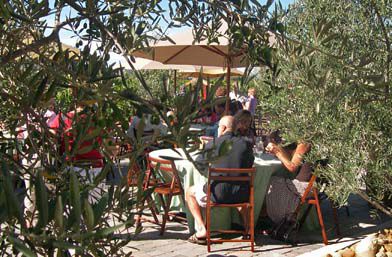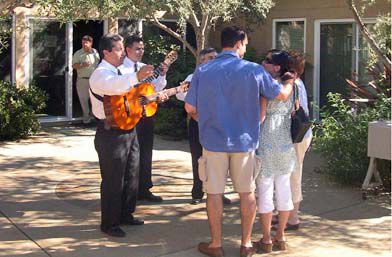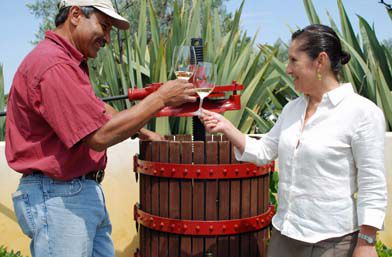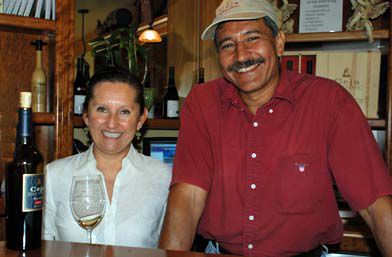Ceja Vineyards Brings Latino Flair to Napa
The Ceja family is living the immigrant’s version of the American dream. From grape pickers to vintners in a single generation, these Latino entrepreneurs were destined to change the face of California’s wine industry. Their dedication has captured the attention of many – including one five-star restaurant in the Napa Valley.
Amelia Ceja (Say-hah), president of Ceja Vineyards, stands on the patio of their Carneros tasting room and gestures towards a large, bronze bell suspended from a wooden pillar. “Every Mexican village has a bell. It’s a symbol of celebration for life,” she states boldly. Engraved on the lower lip is the motto, “Vinum, Cantus, Amor.” Amelia translates, “Wine, Song, Love.” Embossed on their wine label, the ringing bell symbolizes their rich heritage.
Pedro, Amelia’s husband, cordially invites me into their tasting room which was once a quaint bed and breakfast. The beautiful décor has the comfortable feel like home. In the corner is a leather sectional nestled on the stylish dark wood floor. In the next room, an attractive, handcrafted dining table is center-stage.
Pedro positions himself behind the long, mirror-polished bar and pours a generous serving of Ceja Pinot Noir. It quickly becomes evident why Ceja Vineyards are featured on the pages of Wine Enthusiast magazine and the wine list of Napa’s famed, French Laundry.
Ceja Vineyard’s 2004 Pinot Noir introduces itself with a bouquet of juicy red fruit and notes of floral tea. The palate reveals a hint of cranberry and finishes with soft, earthy tannins. This beauty stays in French oak for 20 months before bottling. We visit the 2005 Chardonnay. Immediately, I could taste the crispness of a Granny Smith apple and the tartness of lemon zest. The Chardonnay is free of malolactic fermentation, which explains its lean appeal.
Then we try the 2006 Sauvignon Blanc. This approachable white wine captures notes of gooseberry, kieffer lime and finishes with great minerality.
Amelia asks us to join her in the dining room. We are greeted by a few additional members of the brood and more Ceja wine. Inviting aromas escape the spacious, cabinet-lined kitchen. Amelia approaches the family supporting a serving platter of Carnitas with fresh, halved Jalapeños, crisp cilantro and juicy Roma tomatoes. She rests it beside a heaping mound of homemade pico de gallo and warm white corn tortillas. As we enjoy lunch, the Cejas unfold their beautiful story.
Amelia, the daughter of braceros arrived in Napa from Jalisco, Mexico during September of 1967. She fell in love within her first week in Napa…twice. “My father invited me to pick grapes and I fell madly for them. Then I met Pedro that same day in the field,” she states passionately. At only 12 years old, their future together had begun. “I think it was destiny,” Pedro chimes in.
“I found myself fascinated with the concept of someday being a part of the wine industry,” Pedro adds. As the backbone of the agricultural side of wine making, a Hispanic leaving the fields and becoming a vintner was unheard of. “There’s a certain romanticism in the whole industry of making wine and drinking wine. But I can assure you, there is very little romanticism in picking grapes for a living,” Pedro remarks.
The transition from picking grapes to making wine was a tough one. With the financial assistance of their parents, Pedro, Amelia and Armando (Pedro’s younger brother) purchased 15 acres of a peach orchard in the Carneros district of southern Napa in 1983. At 27 years old, the young couple took on the $400,000 loan while placing their parent’s home as a down payment. “A few months after purchasing the property, my parents lost their jobs. We went through some absolutely horrendous experiences and almost lost it. We even tried to sell the property,” Pedro remarks coarsely. “If you don’t take a chance and try your luck, nothing good or bad will ever happen to you.” he continues.
The Cejas persevered and began growing Pinot Noir. Three years later, they established a contract to sell grapes to the Napa Valley’s Domaine Chandon. They made enough profit to pay down the principle of the loan. “We learned grape growing from the ground up. Then we learned how to do business,” Amelia points out.
In September 2001, Ceja Vineyards released their first vintages. Armando, with a degree in viticulture from UC Davis, became winemaker and brought a generation of vineyard expertise into the winery. They currently produce 7,000 cases and feature eight different wines.
“We are farmers first. We know a thing or two about growing and we want our wines to be an extension of that,” Pedro points out. Amelia adds, “We have such a huge advantage because we have selected the property, do the soil composition studies and select the rootstock and clones. This really allows us to make the style of wines we love.”
As the author of her own wine-friendly cookbook on Mexican cuisine, “Amelia’s Kitchen”, she is as passionate about food as she is wine. “Our background is culinary too. Wine is food,” Amelia states, “We are making wines that are not great just by themselves. Most importantly, they’re great with food.” Amelia doesn’t mind simplifying pairings either. “One of my favorites is our Sauvignon Blanc with popcorn,” she says with a bright smile. “It’s about inviting everyone to enjoy a magical experience,” she adds.
By James Claus
© 2008 Artisan Wine Tours, LLC










